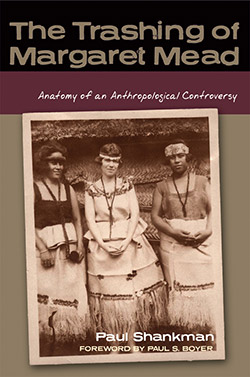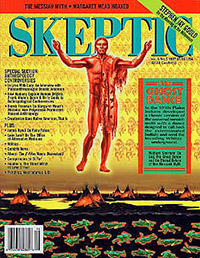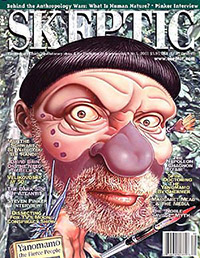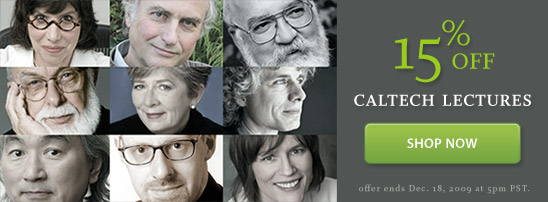In this week’s eSkeptic, we return to a controversy that raged throughout the 1990s in the anthropology world over whether or not Margaret Mead was hoaxed by her Samoan hosts during her research there while earning her Ph.D. under Franz Boaz. When we last left the controversy in the late 90s, it appeared that the jury was in that Mead was duped, but since that time anthropologists have weighed in after careful consideration and concluded that her accuser may not have had the proof he claimed.
The following is an excerpt from The Trashing of Margaret Mead: Anatomy of an Anthropological Controversy by Paul Shankman. Used by permission of the University of Wisconsin Press.
Paul Shankman is a professor of Anthropology at the University of Colorado-Boulder who has done fieldwork in Samoa and authored a number of publications on the Mead-Freeman controversy.
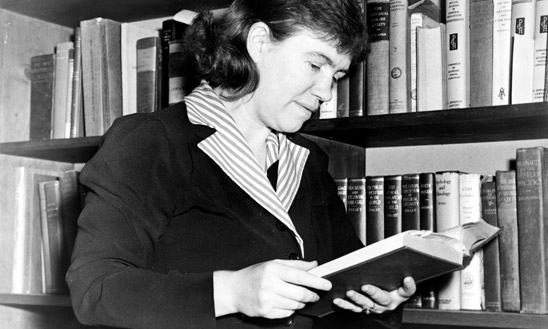
The Trashing of Margaret Mead
How Derek Freeman Fooled Us All
on an Alleged Hoax
excerpt from Paul Shankman’s book
Throughout the 1980s and 1990s the Australian anthropologist Derek Freeman orchestrated a tireless campaign against Margaret Mead, claiming that the American anthropologist had been hoaxed by her Samoan subjects when she conducted her research there as a young graduate student. And for many years Freeman seemed to convince the majority of professional anthropologists and a good deal of general readers that Mead had indeed been duped, her susceptibility due to the powerful influence of her doctoral mentor, Franz Boas, and the potent sway of cultural relativists who believed that behavior is mostly the product of environment, not genes. Thus, it came to be believed by Mead, Boas, and their school of cultural anthropology that the relaxed sexual conduct of the native Samoans was the result of a radically different environment from the sexually stultifying environment of the Industrial West.
Freeman’s claims ranged from his very general observation that Mead may have been misled by Samoans,1 to his unequivocal assertion that Mead was “grossly hoaxed” by two very specific women on the night of March 13, 1926.2 This was not a minor point for Freeman but one of great intellectual significance:
We are here dealing with one of the most spectacular events of the intellectual history of the twentieth century. Margaret Mead, as we know, was grossly hoaxed by her Samoan informants, and Mead in her turn, by convincing others of the “genuineness” of her account of Samoa, completely misinformed and misled virtually the entire anthropological establishment, as well as the intelligentsia at large…. That a Polynesian prank should have produced such a result in centers of higher learning throughout the Western world is deeply comic. But behind the comedy there is a chastening reality. It is now apparent that for decade after decade in countless textbooks, and in university and college lecture rooms throughout the Western world, students were misinformed about an issue of fundamental human importance, by professors who by placing credence in Mead’s conclusion of 1928 had themselves become cognitively deluded. Never can giggly fibs have had such far-reaching consequences in the groves of Academe.3
These allegations about Mead have been repeated so often that they have become conventional wisdom. Martin Gardner, the noted science watcher, found Freeman’s hoaxing argument “irrefutable.” Harvard psychologist Steven Pinker, biologist Richard Dawkins, evolutionary psychologist David Buss, science writer Matt Ridley, classicist Mary Lefkowitz, and many other intelligent people have endorsed the idea that Mead was hoaxed and have deplored her naïvité. Freeman stated the hoaxing argument so boldly and convincingly — after all, it was vouched for by the sworn testimony of one of the women who allegedly hoaxed Mead — that almost no one looked at the testimony itself. People thought the hoaxing argument was completely plausible and the evidence unassailable based on Freeman’s word.
In fact, the hoaxing argument is easily challenged using Freeman’s own unpublished interviews with the Samoan woman on whose testimony Freeman so heavily relied.
The Testimony of Fa’apua’a
In 1989, Freeman identified two Samoan women who he believed had joked with Mead about their private lives. In March of 1926, six months into her fieldwork, Mead was a member of a traveling party that included Fa’apua’a Fa’amu and Fofoa, both of whom were unmarried and somewhat older than Mead herself. It was during her time with these two women that Freeman believed the hoaxing took place.
Over 60 years later, Freeman learned that Fa’apua’a was still alive and well. In 1987 she was interviewed for the documentary film Margaret Mead and Samoa. In that interview, she testified that Mead had asked her and Fofoa embarrassing questions about what they did at night. In response, the two women innocently joked that they spent their nights “out with boys”. According to Freeman, Mead believed these innocent lies as the truth and published them in her classic 1928 book Coming of Age in Samoa, never realizing her error.
Fa’apua’a’s testimony took the controversy over Mead’s Samoan fieldwork in a new direction and became the centerpiece of Freeman’s critique of Mead. In his 1983 book, Margaret Mead and Samoa: the Making and Unmaking of an Anthropological Myth, Freeman attempted to show that Mead was wrong about Samoa and that there were reasons to suspect that she was vulnerable to Samoan joking. After the interview with Fa’apua’a in 1987, Freeman focused his attention primarily on how Mead got Samoa wrong because now he had eyewitness evidence from a Samoan, a woman, and the person who was supposedly Mead’s closest Samoan informant. For Freeman, the interview with Fa’apua’a was beyond anything he had dreamed of in his investigation of Mead. Immediately after the interview, he stated privately that this was the most significant moment of his life.4 The interview became the basis for Freeman’s second book in 1999, The Fateful Hoaxing of Margaret Mead, as well as for a number of articles.
Unpublished Interviews with Fa’apua’a
To his credit, Freeman recognized that the brief and largely unpublished 1987 interview with Fa’apua’a could benefit from additional corroboration and that she might be able to provide more detailed information about Mead’s fieldwork in Samoa. So, in 1988 and again in 1993, he commissioned lengthy interviews with her at her home in American Samoa conducted by Samoan anthropologist Unasa L. F. Va’a.5 Although Freeman himself was not present during these interviews, each lasting several hours and conducted in Samoan, he composed the dozens of very detailed questions and provided them to Unasa who, following the interviews, returned the questions and answers to Freeman at his home in Australia.
In his second book on Mead, Freeman cited these two interviews as indisputable support for the hoaxing hypothesis, stating that Fa’apua’a’s “sworn testimony is of the sort that could be presented in a court of law.”6 Since Fa’apua’a was 87 in the 1988 interview and 92 in the 1993 interview, Freeman posed questions that checked the accuracy of her memory, and he determined that there was “quite definite evidence that Fa’apua’a, in 1993, as in 1988, had substantially accurate memories of Manu’a in 1926.”7 However, these interviews with Fa’apua’a were not published and did not become available until after Freeman’s death in 2001. What they demonstrate is that Fa’apu’a’s testimony is sometimes contradictory or unclear, and that it does not support Freeman’s hoaxing argument on key issues.
Freeman maintained that the interviews laid to rest concerns about Fa’apua’a’s memory. He wrote that even at age 92, Unasa had found Fa’apua’a still “lucid” and “still able to remember well.”8 On a number of matters, this was certainly true, but on other matters, Fa’apua’a seemed to be losing her memory. So, according to Unasa, in 1993 Fa’apua’a had forgotten that Mead had died, expressing her sorrow when Unasa reminded her of it; she had learned of Mead’s death six years earlier and had grieved then.9 In another instance, when asked if elopement occurred in Samoa in the 1920s, Fa’apua’a replied that she had not heard of any cases, although this was the most common form of marriage at that time.10 Nor could she remember any cases of boys surreptitiously visiting their girlfriends, illegitimate children, adultery, or rape. These responses seemed so improbable to Freeman that, in notes to himself on the interview transcripts, he placed question marks next to Fa’apua’a’s answers concerning elopement, surreptitious visits, and illegitimate children.11 They did not conform to what Freeman knew about Samoa in the 1920s. Nevertheless, he affirmed the “historical reliability” of her testimony.12
At times during the unpublished interviews, Fa’apua’a offered differing answers to key questions. Although identified by Freeman as Mead’s main informant, Fa’apua’a herself was unclear about this role. In the 1988 interview, she was asked if she was Mead’s “closest Samoan friend and informant,” to which she replied, “Yes.”13 But later in the same interview, she was asked if she actually worked with Mead as an informant at the house where Mead resided, to which she replied, “Only once.”14 When asked what kinds of questions Mead posed at that time, Fa’apua’a said that she did not remember. In his notes on the interview transcript, Unasa commented parenthetically, “[Fa’apua’a] Fa’amu gives the impression that she was not a good informant for Mead. If she did not know anything, she told Makerita [Mead] so, and encouraged her to ask others.”15
Fa’apua’a also offered different accounts of Mead’s language proficiency in Samoan. In one published interview, she stated that Mead spoke “very little” Samoan and that a translator was “always” used in their conversations.16 But in the unpublished interviews, Fa’apua’a stated that Mead understood Samoan well, that no one else was present at the time of the alleged hoaxing, that she asked Fa’apua’a and Fofoa questions in Samoan, and that Fa’apua’a “always” spoke to Mead in Samoan since she did not speak English well.17
In another instance of differing answers, Fa’apua’a was asked to recall the chronological sequence of the hoaxing in more detail. Freeman stated that it occurred on the specific night of March 13, 1926, and that he was able to use Fa’apua’a’s testimony to corroborate this date. But in the unpublished 1993 interview, Fa’apua’a actually stated that she and Fofoa had joked about sex with Mead over an “extended period” of time.18 Unasa commented parenthetically that, “What Fa’apua’a is saying is that there was no one specific time when she and Fofoa misled Mead about Samoan sexual mores.”19 Moreover, even the geographic location of the hoaxing is unclear from the interviews.
There were clearly problems with Fa’apua’a’s testimony in the unpublished interviews. Fa’apua’a was not a key informant for Mead on adolescent sexuality, a point that anthropologist Martin Orans and sociologist James Cote have independently established.20 And without agreement on when and where the hoaxing took place and in what language it took place, the most basic facts about it were, at best, ambiguous. Given these problems, Freeman’s continuing reliance on Fa’apua’a’s testimony and the hoaxing hypothesis is puzzling. He could have addressed them. Instead, he filed the interviews away and continued to promote the hoaxing hypothesis as if Fa’apua’a was Mead’s main informant and as if there were no inconsistencies, no ambiguities, no contradictions in the interviews, and no lapses in Fa’apua’a’s memory.
To Good To Be True
Freeman went to great lengths to convince a broad audience that Mead had been hoaxed. But the “hoaxing” argument was implausible because the interviews that Freeman used did not support his hypothesis. It is also unnecessary, for Mead’s interpretation of Samoa as a sexually permissive society was not due to her alleged “hoaxing” by Fa’apua’a and Fofoa, but rather the data that she collected from Samoan adolescent girls and from other Samoan men and women, her comparison of Samoa and America in the mid-1920s, and the social agenda that she advocated given her own personal background and interests.
Mead was a competent fieldworker who spoke Samoan with a degree of fluency and who understood Samoan joking. Nevertheless, Freeman argued that the unpublished interviews with Fa’apua’a’ were of “exceptional historical significance” and of “quite fundamental importance” because they demonstrated Mead’s gullibility and naivite.21 Moreover, he believed that the interviews absolved Mead from engaging in the deliberate misrepresentation of Samoan culture, finding instead that she was fatefully “misled” by Fa’apua’a and Fofoa.22 That is, Mead was the unwitting victim of her own inexperience and prior beliefs rather than the conscious perpetrator of ethnographic fraud. In his words, Mead was in “a chronic state of cognitive delusion.”23 For Freeman, Mead was not intentional cheat — just a foolish young woman. In this way, Freeman believed that he salvaged Mead’s reputation and brought the controversy to an end. It was an ingenious argument. It was also an intellectual house of cards.
Freeman stated his argument so boldly and presented it with such certainty that it seemed believable. In fact, it seemed foolish not to believe him. Almost no one thought that it might be a good idea to look at the actual interviews with Fa’apua’a and to ask if Freeman’s certitudes about the value of her testimony were warranted. These unpublished interviews with her demonstrate that there is no compelling evidence that Mead was hoaxed. It was a good story — a story that many people wanted to believe. Alas, it was a story that was too good to be true.
References
- Freeman, Derek. 1983. Margaret Mead and Samoa: The Making and Unmaking of an Anthropological Myth. Cambridge: Harvard University Press, 289–90.
- Freeman, Derek. 1997. “Paradigms in Collision: Margaret Mead’s Mistake and What It Has Done to Anthropology. Skeptic. Vol. 5, No. 3, 68.
- Ibid.
- Oxley, Peter. 2006. “Tales From the Jungle: Margaret Mead.” BBC documentary.
- Unasa L.F Va’a. 1988 and 1993. “Research Materials.” Derek Freeman Papers. Mandeville Special Collections. Geisel Library. University of California at San Diego.
- Freeman, Derek 1999. The Fateful Hoaxing of Margaret Mead. Boulder, CO: Westview Press, 13.
- Ibid.
- Ibid.
- Unasa, 1993. Research Materials, 6.
- Ibid, 1988, 33b.
- Ibid, 1988, B.
- Freeman, 1999, 13.
- Unasa, 1988, 25.
- Ibid., 67.
- Ibid., 68.
- Gartentsein, Larry. 1991. “Sex, Lies, Margaret Mead, and Samoa.” GEO. Vol. 13, No. 6, 23.
- Unasa 1993, 44.
- Ibid., 43.
- Ibid., 42.
- Orans, Martin. 1996. Not Even Wrong: Margaret Mead, Derek Freeman, and The Samoans. Novato, CA: Chandler & Sharp, 90–100. Cote, James. 1998. “Much Ado About Nothing: The Fateful Hoaxing of Margaret Mead.” Skeptical Inquirer, Vol. 22, No. 6, 29–34.
- Freeman, Derek. 1999. The Fateful Hoaxing of Margaret Mead. Boulder, CO: Westview Press. 4.
- Ibid, 12.
- Freeman, Derek. 1991. “There’s Tricks I’ th’ World: An Historical Analysis of the Samoan Researches of Margaret Mead.” Visual Anthropology Review. Vol. 7, No.1, 115–116.

Evolutionary Medicine (Part Two)
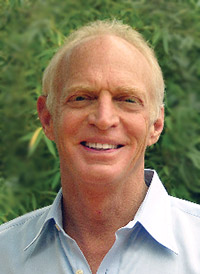
Dr. William Meller
Insomnia; depression; attention-deficit hyperactivity disorder; sexual infidelity. Most of us have dealt with at least one of these issues in our lives, and no wonder — so did our ancient ancestors.
This week on Skepticality, Swoopy welcomes back Dr. Willam Meller for a second round of discussion based on his book Evolution RX. How do the adaptations of early humans affect our emotions, behaviors and modern daily lives? Evolutionary medicine looks at those very questions.
Watch full-length sample lectures

NEW ON MICHAELSHERMER.COM
Scientific American columns
Read the October and November issues of Michael Shermer’s Scientific American columns for free on michaelshermer.com. October: Captain Hook Meets Adam Smith. November: Will E.T. Look Like Us?
READ the October column
READ the November column
NEW ON TRUE/SLANT
A Wacky Night on Coast-to-Coast Radio
Shermer shares some of the wackier letters he received after his appearance with George Noory on Coast-to-Coast AM Radio, whichs covers conspiracy theories and government coverups, UFOs and extraterrestrials, psychics and ESP, and all manner of supernatural and paranormal ephemera.
READ the post


